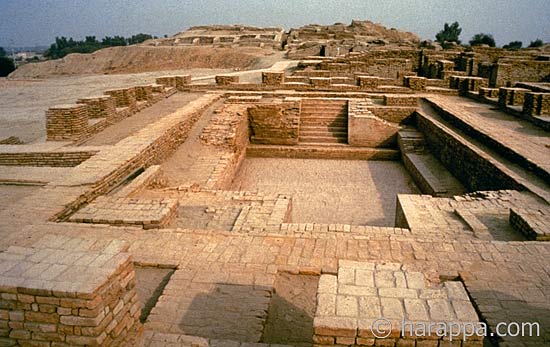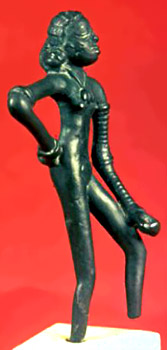Difference between revisions of "Mohenjo Daro"
Brkushwaha (Talk | contribs) (New page: to be continued) |
|||
| Line 1: | Line 1: | ||
| − | to | + | == Material Markers of Mohenjo Daro == |
| + | As we learned previously, the common material markers of society are cities, bronze technology, writing, great ceremonial buildings, temples, monumental art, hierarchies and class divisions, some form of law, held together with an organized military. The material markers of Mohenjo Daro include great buildings and temples (however no stone sculptures), symbolic art, bronze technology, their Indus writing and social classes. The most interesting detail, however;is that no evidence for an organized military force or any battles were found at the Mohenjo Daro site. Further evidence is the fact that now walls exist. | ||
| + | |||
| + | |||
| + | == Buildings and Temples == | ||
| + | |||
| + | Excavations at Mohenjo daro revealed the "Great Bath", a massive columned building and water tank pictured below.This is the first public water system in history. In addition the archeologist uncovered a mysterious building with brick foundation and sockets for a wooden super structure and even multiple doorways inside. This building is a mystery to archeologists because its use has not been determined, yet it is a huge building. For extended information on the Baths, see http://www.harappa.com/indus/8.html | ||
| + | |||
| + | http://www.harappa.com/indus/gif2/greatbath.jpg | ||
| + | |||
| + | |||
| + | == Art == | ||
| + | |||
| + | While no monumental art was created by the inhabitants of Mohenjo Daro, small art pieces and sculptures were found. Two prime examples are the dancing girl of Mohenjo Daro (pictured below), and the sculpture of a high priest. The dancing girl shaped out of bronze proves that the inhabitants of Mohenjo Daro were highly skilled bronze workers. | ||
| + | |||
| + | http://www.indianetzone.com/photos_gallery/7/DancingGirl_md_19432.jpg | ||
| + | |||
| + | See http://www.mohenjodaro.net/ for pictures | ||
Revision as of 13:23, 21 March 2012
Material Markers of Mohenjo Daro
As we learned previously, the common material markers of society are cities, bronze technology, writing, great ceremonial buildings, temples, monumental art, hierarchies and class divisions, some form of law, held together with an organized military. The material markers of Mohenjo Daro include great buildings and temples (however no stone sculptures), symbolic art, bronze technology, their Indus writing and social classes. The most interesting detail, however;is that no evidence for an organized military force or any battles were found at the Mohenjo Daro site. Further evidence is the fact that now walls exist.
Buildings and Temples
Excavations at Mohenjo daro revealed the "Great Bath", a massive columned building and water tank pictured below.This is the first public water system in history. In addition the archeologist uncovered a mysterious building with brick foundation and sockets for a wooden super structure and even multiple doorways inside. This building is a mystery to archeologists because its use has not been determined, yet it is a huge building. For extended information on the Baths, see http://www.harappa.com/indus/8.html

Art
While no monumental art was created by the inhabitants of Mohenjo Daro, small art pieces and sculptures were found. Two prime examples are the dancing girl of Mohenjo Daro (pictured below), and the sculpture of a high priest. The dancing girl shaped out of bronze proves that the inhabitants of Mohenjo Daro were highly skilled bronze workers.

See http://www.mohenjodaro.net/ for pictures